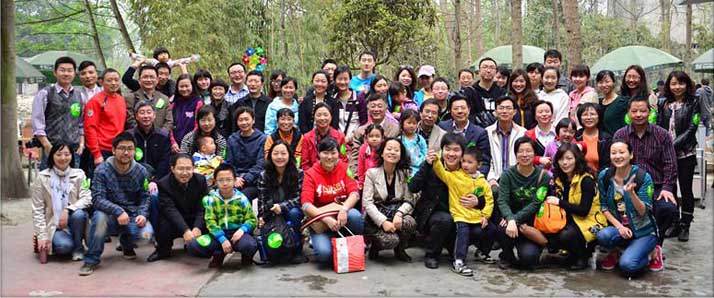Introduction to School of Foreign Languages, Southwest Jiaotong University

School of Foreign Languages (SFL) originates from the Department of Foreign Languages which was set up in 1985 and began to enroll undergraduates in 1987. However, its history of foreign language teaching is much longer. When the Imperial Chinese Railway College (the origin of Southwest Jiaotong University) was founded in 1896, the first students had courses all taught in foreign languages except “Advanced Chinese”, and Professors Challe from Germany, Sprague from the US and Griffith from Britain served as Chief Tutor successively from 1896 to 1908. The tradition of foreign language teaching and learning was preserved no matter whatever name the College was given and wherever it was located.
The SFL, officially founded in 2001, has 168 faculty members, of whom 12 are professors and 34 associate professors. There are more than 40 PhD and MA supervisors. The School offers 6 programs of bachelor of arts (BA) degree in English, German, French, Japanese, Translation and Interpreting, and International Chinese Education. Of the six majors, English, Translation and Interpreting, and German have been authorized by the Ministry of Education (MOE) of the People’s Republic of China to develop the national first-class undergraduate major, and the other three, Japanese, French and International Chinese Education have been authorized to develop the province-level first-class undergraduate major. As for the graduate programs, the SFL offers the master program of Foreign Language and Literature (including English Language and Literature, Foreign Linguistics and Applied Linguistics, Translation Studies, and Comparative Literature and Cross-cultural Studies), and 2 professional master programs (Master of Translation and Interpreting, Master of International Chinese Education). Since 2010, in collaboration with the School of Humanities, the SFL has offered the PhD program in Medio-translatology. Besides, Foreign Language and Literature has been honored as the first-class discipline of Sichuan Province. The School is also in charge of providing various English for General/Specific/Academic Purposes courses for students from other schools and colleges.
The SFL attaches great importance to teaching and talent training. Up till now, 5 nation-level first-class courses, and more than 20 province-level first-class courses have been set up, and the School has received high recognition for its teaching quality including several nation-level and province-level excellent teaching awards won by faculty members and a large number of prizes won by students in various kinds of speech contests, language writing competitions, and translation competitions.
Over the past years the faculty members have produced outstanding academic research fruits, especially the publication of research articles in the SSCI, A&HCI, CSSCI indexed journals, monographs, textbooks, and translated works, and have succeeded in receiving a large number of research grants funded by the National Social Science Fund of China, the Humanities and Social Science Fund of Ministry of Education, and the Social Science Fund of Sichuan Province. The SFL-in-charge project of “Research on Goethe and the Translation of His Works into Chinese” is the first Major Project funded by the National Social Science Fund of China in the history of Southwest Jiaotong University. Some of the faculty members’ published monographs have won 8 prizes for excellent philosophy and social sciences research fruits, of which 1 third prize was awarded by the Ministry of Education, and 2 second prizes and 5 third prizes awarded by the People’s Government of Sichuan Province. Besides, the team of engineering translation has been in charge of translating several of China’s railway technical standards (C-E).
To promote academic research, the SFL has set up the Center of Cultural Exchange Studies approved by the MOE, the Center for American Studies and the Center for European Studies listed by the MOE among the centers of area studies, and one university-based new humanities and social sciences laboratory specializing in language data processing and application. The SFL joined hands with Lan-bridge Communications Ltd and established the Southwest Jiaotong University-Lan-bridge Translation Center in the hope of training high-quality MTI talents. The SFL International Communication Center, based on the professional faculty members majoring in international Chinese education, has carried out quite a few projects of cultural exchange funded by the Center for Language Education and Cooperation, MOE, and, in particular, the YouthLink featured project has become a greatly influential platform for young generations to have dialogues.
The SFL has set up a partner relationship of exchange and collaboration with more than 20 international universities around the world, including Columbia University in the City of New York (USA), University of California, Davis (USA), University of Leeds (UK), University of Strathclyde (UK), McGill University (Canada), University of Ottawa (Canada), Université Lumière Lyon 2 (France), Ruhr University Bochum (Germany), University of Yamanashi (Japan) and Metropolitan University Prague (Czech). More than 1,000 students of the SFL have studied abroad and the SFL has received more than 500 international students.
CONTACT:
Address:
Room 30807, Teaching Building 3, School of Foreign Languages, Southwest Jiaotong University, No. 999, Xi’an Road, Pidu District, Chengdu City, Sichuan Province, P. R. China 611756
犀浦校区地址:中国四川省成都市郫都区犀安路999号 西南交通大学外国语学3号楼30807办公室
Tel: 0086-28-66366711
E-mail: wgyxy@home.swjtu.edu.cn (to Mr. Wang)